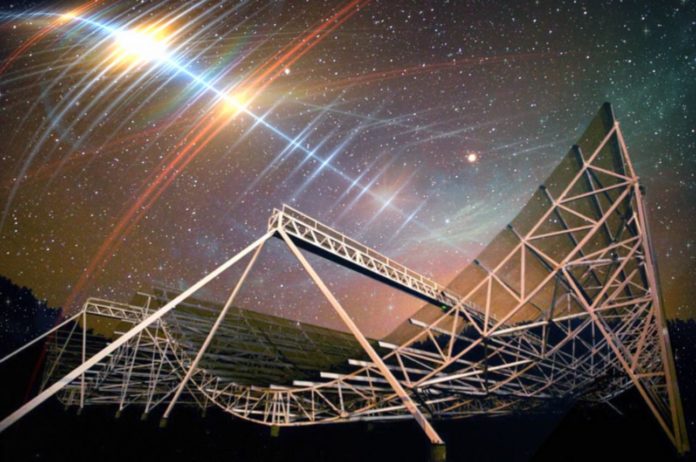Astronomers from MIT and other institutions have identified an enigmatic, persistent radio signal emanating from a distant galaxy, which appears to flash with startling regularity.
The signal is categorized as a fast radio burst (FRB), which is a brief but extremely powerful burst of radio waves with an unknown astrophysical origin.
However, compared to the typical FRB, this novel signal lasts up to three seconds or 1,000 times longer. Within this window, the researchers identified radio waves with a definite periodic pattern that repeats every 0.2 seconds, similar to a beating heart.
The signal, FRB 20191221A, was identified by the researchers as the longest-lasting FRB to date and has the most distinct periodic pattern.
The signal’s origin is in a faraway galaxy billions of light-years away from Earth. Astronomers believe the signal may have come from either a radio pulsar or a magnetar, two different forms of neutron stars that are incredibly compact and fast-spinning collapsed cores of big stars. However, the precise nature of that source is yet unknown.
According to Daniele Michilli, a postdoc at MIT’s Kavli Institute for Astrophysics and Space Research, “There are not many things in the universe that emit strictly periodic signals.”
Radio pulsars and magnetars, which revolve and emit a beamed output akin to a lighthouse, are examples that we are aware of in our own galaxy.
“And we think this new signal could be a magnetar or pulsar on steroids.”
The researchers aim to find other periodic signals from this source, which might subsequently be utilized as an astrophysical clock. For instance, the velocity of the universe’s expansion might be gauged by the frequency of the bursts and how they alter as the source travels away from Earth.
The finding was published today in Nature by members of the CHIME/FRB Collaboration, including MIT co-authors Calvin Leung, Juan Mena-Parra, Kaitlyn Shin, and Kiyoshi Masui, as well as Michilli, who led the discovery as a researcher at McGill University and then as a postdoc at MIT.
“Like a heartbeat”
Since the first FRB was found in 2007, hundreds of comparable radio flashes have been observed throughout the cosmos. The most recent discovery was made by the Canadian Hydrogen Intensity Mapping Experiment, or CHIME, an interferometric radio telescope made up of four sizable parabolic reflectors at the Dominion Radio Astrophysical Observatory in British Columbia, Canada.
CHIME, which is built to detect radio waves produced by hydrogen in the very early phases of the universe, continuously scans the sky as the Earth spins. The telescope is also capable of picking up fast radio bursts, and since it started scanning the sky in 2018, CHIME has picked up hundreds of FRBs coming from various locations.
The vast majority of FRBs that have been seen so far are one-offs, which are ultrabright radio wave bursts that last just a few milliseconds before disappearing. Recently, scientists made the first observation of a periodic FRB that seemed to generate a predictable pattern of radio waves. A four-day span of erratic bursts that then repeated every 16 days made up this signal. Despite the fact that the signal of the actual radio bursts was random rather than periodic, this 16-day cycle showed a periodic pattern of activity.
On December 21, 2019, CHIME detected a probable FRB signal, which grabbed Michilli’s quick attention as he scanned incoming data.
“It was unusual,” he recalls. “Not only was it very long, lasting about three seconds, but there were periodic peaks that were remarkably precise, emitting every fraction of a second — boom, boom, boom — like a heartbeat. This is the first time the signal itself is periodic.”
Brilliant Boom
When Michilli and his colleagues looked at the pattern of the radio bursts from FRB 20191221A, they found similarities with the emissions from radio pulsars and magnetars in our own galaxy. While magnetars produce a comparable emission because of their strong magnetic fields, radio pulsars emit beams of radio waves that appear to pulse as the star rotates.
FRB 20191221A looks to be more than a million times brighter than radio emissions from our own galactic pulsars and magnetars, which is the fundamental distinction between the new signal and those from those objects. According to Michilli, the light flashes may be the result of a distant radio pulsar or magnetar that, for some reason unknown to scientists, unleashed a series of brilliant bursts during a brief three-second window that CHIME was fortunate enough to observe.
“CHIME has now detected many FRBs with different properties,” Michilli adds. “We’ve seen some that live inside clouds that are very turbulent, while others look like they’re in clean environments. From the properties of this new signal, we can say that around this source, there’s a cloud of plasma that must be extremely turbulent.”
The periodic FRB 20191221A is expected to produce more bursts, which could help astronomers better understand neutron stars in general and its source.
“This detection raises the question of what could cause this extreme signal that we’ve never seen before, and how can we use this signal to study the universe,” says Michilli, adding “Future telescopes promise to discover thousands of FRBs a month, and at that point we may find many more of these periodic signals.”
Image Credit: CHIME
You were reading: Detected: A Strange Radio “heartbeat” Billions Of Light-years From Earth
